Traditional English Pancakes Recipe
Traditional English Pancakes are so simple but always feel like a treat. Made with just flour, eggs, milk, and salt, they’re most often served with a sprinkle of sugar and a squeeze of lemon. Usually reserved for Shrove Tuesday or Pancake Day, I think they’re so easy and tasty there’s no reason you can’t make them all year round – and serve them with savoury fillings too!
This is an updated version of a post first published in 2023
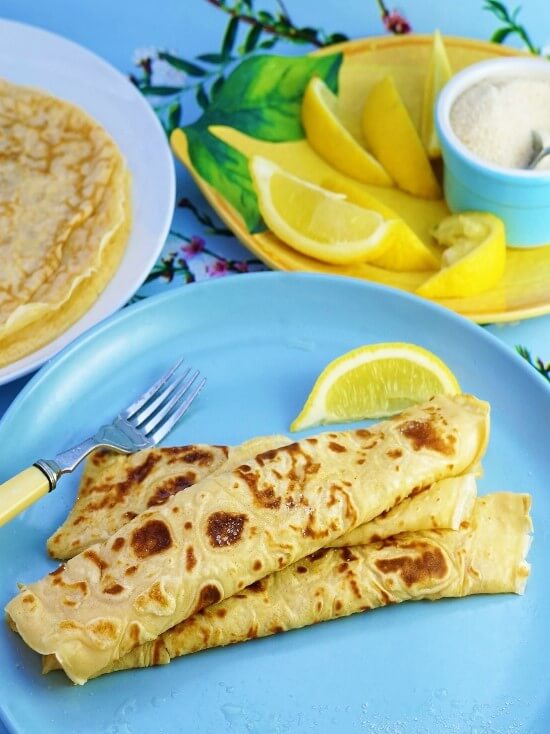
Jump to Recipe
When I was growing up in the English Midlands in the 1970s and 80s, the only time we ate pancakes was on Pancake Day aka Shrove Tuesday. We’d so look forward to it, I don’t know why we didn’t have them more often. After all, the basic, cheap ingredients were ones that were always in the fridge and pantry. The only thing that needed to be bought-in specially (fresh lemons unknown in our house) was a Jif plastic lemon for squeezing over the hot pancakes.
These days, pancakes seem to be enjoyed more frequently. However, the increased popularity seems largely to be for smaller, thicker and fluffier pancakes. But I think that delicate, crêpe-like Traditional English Pancakes are just as good. And that’s true whether you prefer them sweet or savoury.
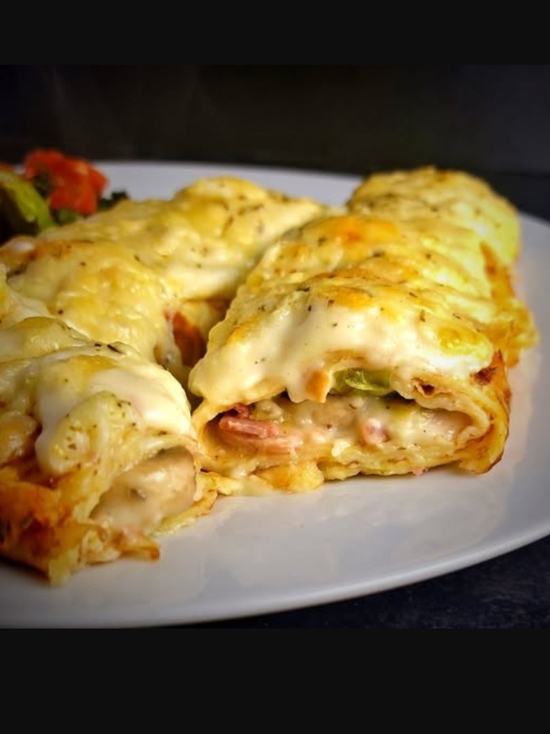
WHAT ARE ENGLISH PANCAKES?
After some thought, I decided to call these pancakes English rather than British. That’s because both Scotland and Wales are associated with the thicker style of pancakes: see Scotch (or Scottish) pancakes and Welsh crempogau. In Northern Ireland, it seems less clear cut, although my brief research did suggest a preference for thick pancakes there too. Perhaps a hangover from the Scottish ancestry of many Protestants?
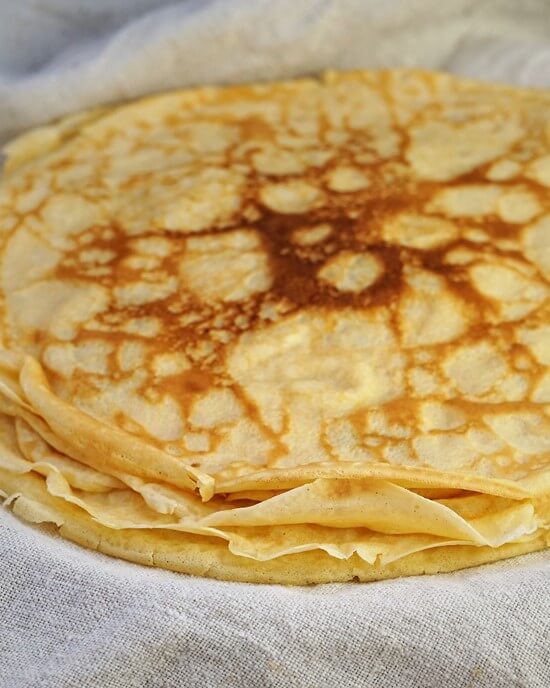
Traditional English Pancakes differ from those thick, fluffy pancakes in two ways. First, they contain no raising agent such as baking powder or bicarbonate of soda. Their only ingredients are plain flour, eggs, milk, plus fat to fry them in. This necessarily results in a flatter pancake. English pancakes are also much larger, generally covering the whole base of the frying pan they’re made in. The result is similar to French crêpes, although the English version is usually made a little thicker.
SHROVE TUESDAY & PANCAKE DAY
Popularly known as Pancake Day, Shrove Tuesday is the feast day before the start of Lent. This is the 40 days of fasting leading up to Easter. However, Lent is thought to have much older roots in pagan traditions of springtime fasting. Just as with Mardi Gras (literally ‘Fat Tuesday’), on Shrove Tuesday rich, fatty foods like eggs and milk were used up before the period of abstinence. And pancakes, fried in oil and/or butter, fit the bill perfectly.
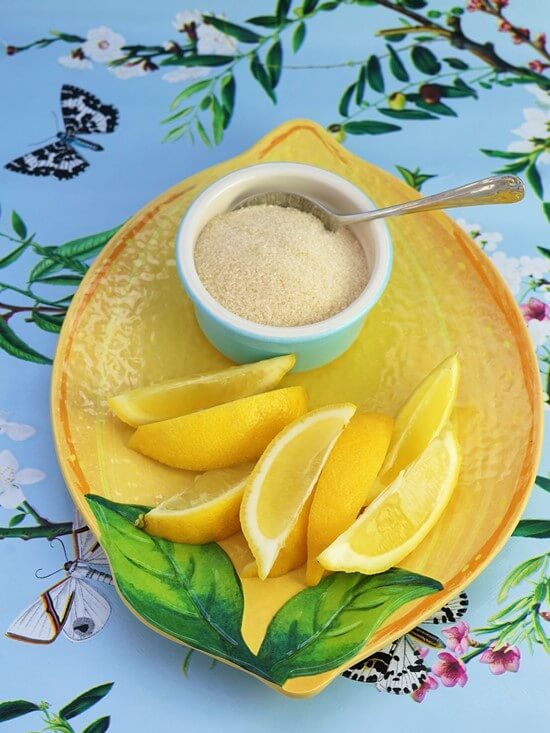
Having said that, I’m pretty sure millions of us making pancakes on Shrove Tuesday aren’t doing it in preparation for a fast. It’s because we love them! In any case, my Traditional English Pancakes with their simple accompaniments of sugar and lemon juice aren’t exactly hedonistic. For 8 large pancakes, serving 2 per person, you only need 2 eggs, 300 ml of milk, plain flour, a pinch of salt, plus a little oil and butter for frying.
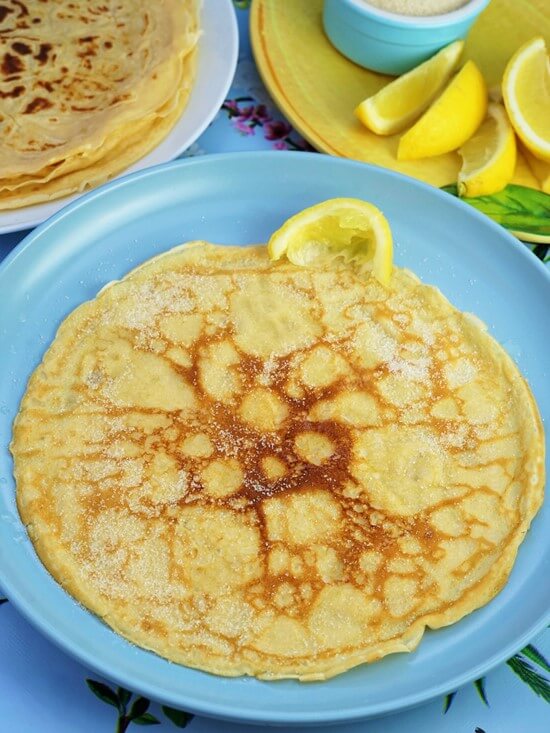
EASY TRADITIONAL ENGLISH PANCAKES
If you’ve never made pancakes before, then you might be surprised at how easy they are. Your first few might not be perfect, but with a little practice you’ll be cooking a whole batch in 20 – 25 minutes. You’ll find detailed instructions in the recipe card at the end. But I recommend reading the rest of the post for extra tips and step-by-step images first.
PANCAKE BATTER
Making the pancake batter is only going to take you around 5 minutes. You start by sifting the flour and salt into a bowl. Then you crack in the eggs along with roughly 50 ml of the milk. Using a whisk (there’s no need for electric beaters), you beat the eggs and milk together while also gradually drawing in the flour. What you’re aiming for at this stage is a thick, lump-free batter. When you have that, you can gradually whisk in the remaining milk. For easier pouring later, I transfer the finished batter to a jug.
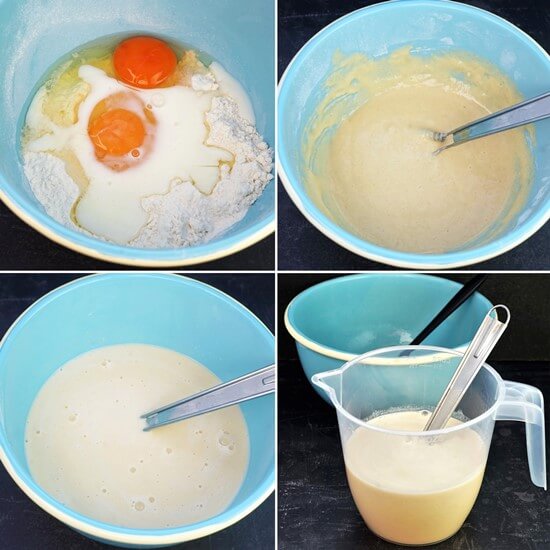
Ideally, you should now rest it in the fridge for 30 minutes. This is so the flour can properly absorb the liquid which is said to reduce the chance of an overly chewy pancake. However, I’ve been known to occasionally skip this step and the pancakes have still tasted good. If convenient, you can make in advance and leave for up to 2 hours.
THE FRYING PAN & THE FAT
Traditional English Pancakes are usually between 18 – 20 cm in diameter. To get a nice, round pancake, you should cook them in a non-stick frying pan of that size. Although you can buy specialist pancake and crêpe pans, so long as your pan is on the shallow side, has a flat base and good, even heat distribution you should be fine. I actually use a pan bought many years ago for making Indian dosa and it’s perfect.
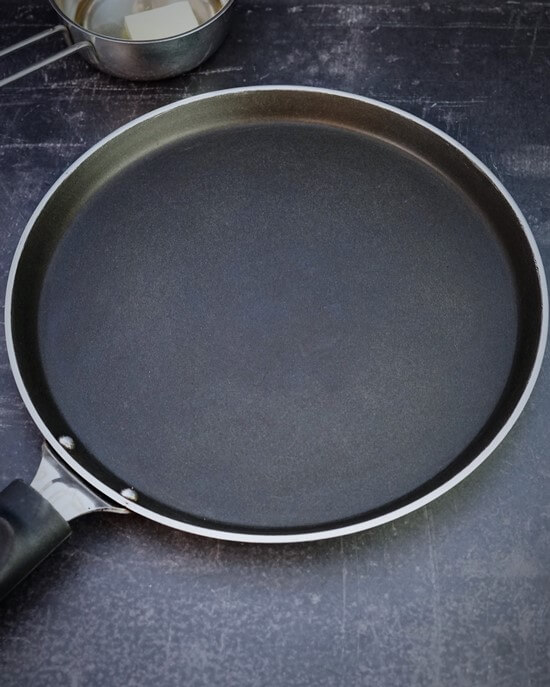
I like to cook my pancakes in a mixture of butter and sunflower oil. The butter adds a little flavour, and the oil stops it burning. I melt them together in a small saucepan or in the microwave. You need very little though. I brush some over the hot pan then pour or wipe off any excess.
MAKE SURE THE PAN IS HOT BEFORE YOU BEGIN
The thin pancakes should be cooked over medium-high heat: my electric hob goes up to 6 and I have it at 4. Note that the butter-oil mixture should be sizzling before you add any batter. My recipe makes approximately 500 ml of batter. So, dividing that by 8 pancakes, you need just over 60 ml per pancake. Conveniently, if you have a set of American measuring cups, that’s a generous quarter cup each.
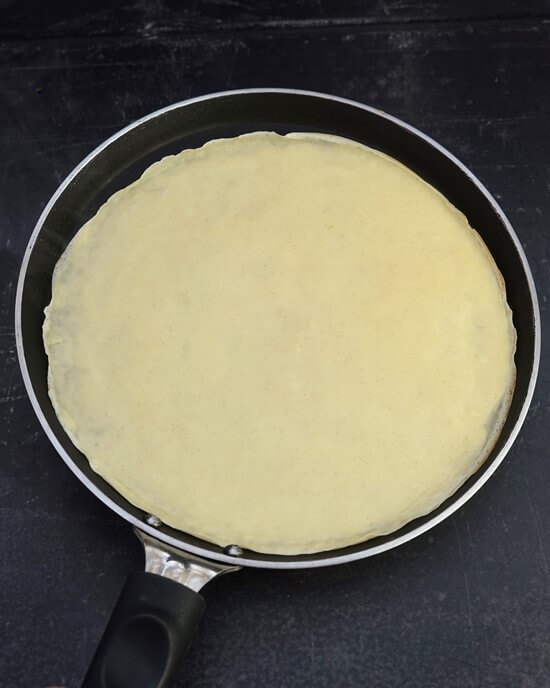
As you pour the batter into the hot pan, lift and tilt so it runs and flows to completely cover the base. Now leave it on the heat until the underneath is light golden brown (use a knife or spatula to take a peek) and the upper side looks dry with no liquid batter. This should take no longer than 1 ½ – 2 minutes.
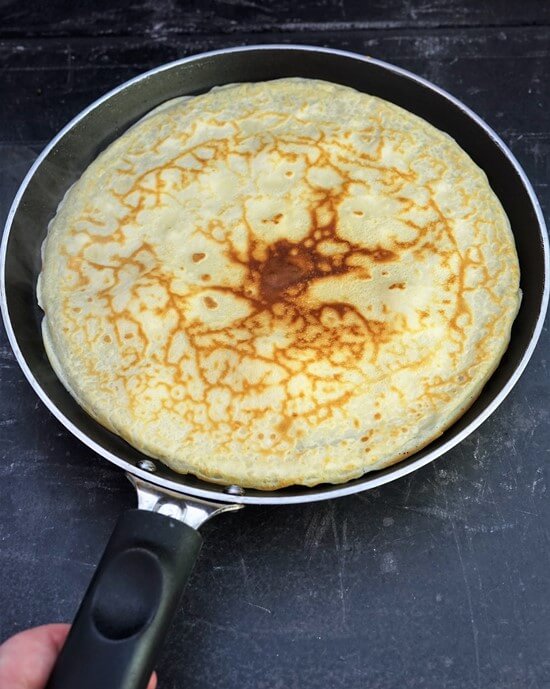
Now turn over or, if you are confident enough, flip the pancake and cook the second side. This should be done in about a minute, its surface covered in brown circles.

As each pancake is cooked, you can stack and wrap them in a clean tea towel to keep warm. But they reheat well anyway, so don’t worry too much about that. Just keep regreasing the pan, taking out the excess, and making pancakes until all the batter is used up.
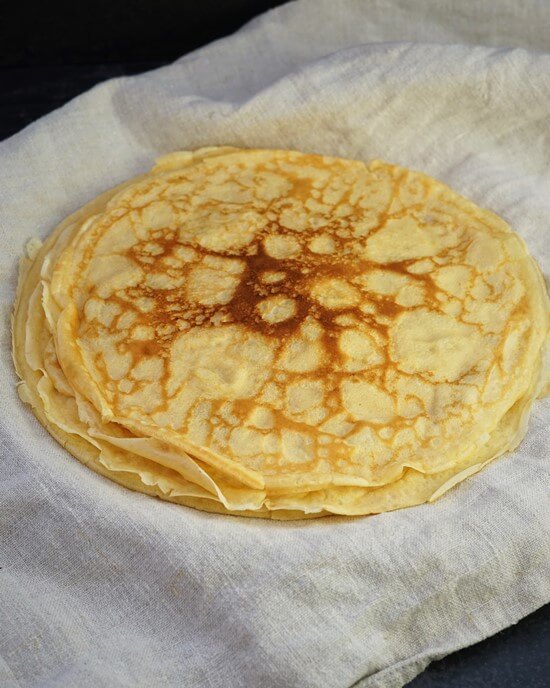
If you need to reheat the pancakes, the easiest way is to transfer the stack to the microwave and heat on full power for a minute or so. You can also wrap in foil and put in a medium oven for 5 – 10 minutes. If making in advance, they’ll be fine in the fridge for a few days. You can also freeze pancakes, layering them with greaseproof paper to make separation easier.
SERVING TRADITIONAL ENGLISH PANCAKES
I’m sure that people have come up with all sorts of weird and wonderful toppings for Traditional English Pancakes. But I think you can’t beat good old sugar and lemon juice. Take one hot pancake, sprinkle over the sugar, then take a lemon wedge and squeeze it all over. I always roll my pancake up to eat, but you could fold into quarters if you like. Then dig in.
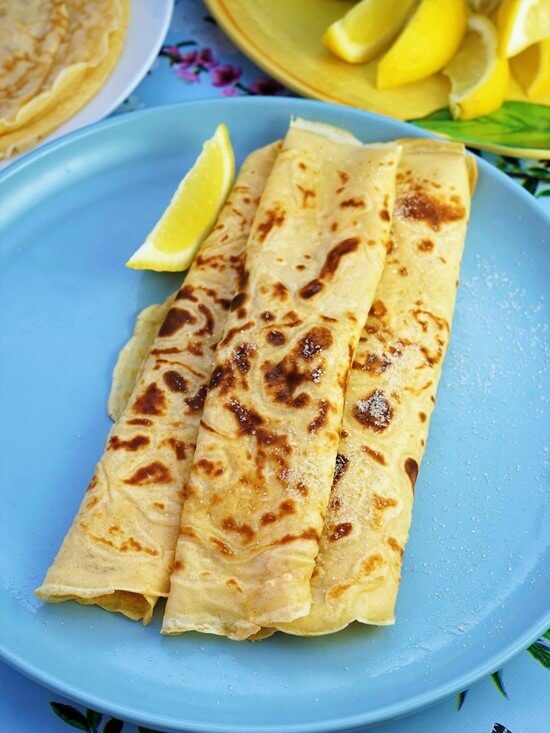
If you’ve never eaten this type of pancake before, you might be surprised at how good such a simple thing can be. Light but tasty with the clean, fresh zing of sweetened lemon. Another simple but delicious way to eat sweet pancakes is to omit the lemon and add a blob of Homemade Strawberry Jam before rolling up.
However, as there’s no sugar in the pancakes themselves, they also work brilliantly with savoury fillings like cheese and ham. The easiest method is, once the second side is cooked, add the filling, fold in half and leave in the pan for a minute or two to heat the cheese and warm the ham.
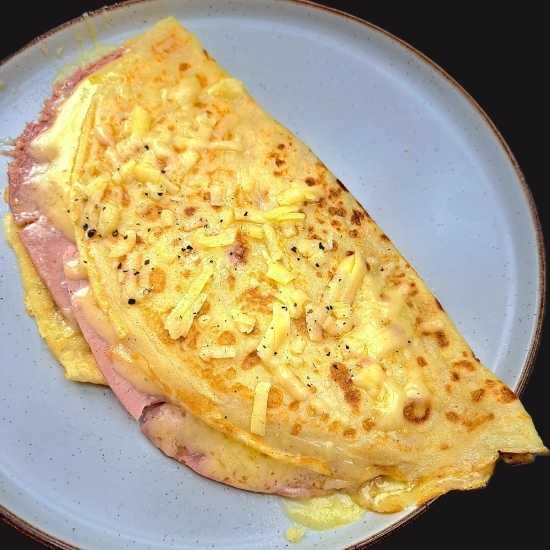
But if you’ve a little more time and want something a bit special, take a look at the stuffed and baked savoury Traditional English Pancakes up near the top of this post. For those, I sauteed mushrooms, leeks and garlic then folded them, plus a little chopped ham, through a cheese sauce. Filled and rolled, I put the pancakes in a dish with some reserved cheese sauce on top and baked until hot and bubbling. Delicious!
So versatile but dead simple, sweet or savoury, I’ll always come back to these English classics.
HAVE YOU MADE THESE PANCAKES? LEAVE A COMMENT & RATING TO LET ME KNOW HOW IT WENT

Traditional English Pancakes Recipe
A simple treat made with just plain flour, eggs and milk. Traditionally eaten on Shrove Tuesday, the crepe-like pancakes are usually eaten with a sprinkle of sugar and a squeeze of lemon, but they're equally good with savoury fillings like cheese and/or ham.
It's recommended that you read the accompanying blog post before beginning the recipe.
Ingredients
- 120 g plain flour
- 1 pinch salt
- 2 eggs
- 300 ml milk
For frying
- 10 g butter
- 2 tsp sunflower oil
To serve (optional)
- sugar for sprinkling
- 1 lemon cut into 8 wedges
Instructions
Make the batter
-
Sift the flour and salt into a mixing bowl.
Make a well in the middle and crack in the eggs.
Pour in 50 ml of the milk then, using a whisk, beat the eggs and milk together while gradually drawing in the flour to form a thick, smooth batter.
Gradually whisk in the remaining milk.
Transfer the batter to a jug and set aside.
Tip: the batter can be used straight away, but is better if left for a minimum of 30 minutes and up to 2 hours in the fridge.
Fry the pancakes
-
Put the butter and oil in a small saucepan or a suitable container in the microwave and heat until the butter melts.
Put a shallow, 18 - 20 cm non-stick frying pan, crepe or pancake pan over medium-high heat.
When hot, brush over a thin layer of the butter and oil, wiping off any excess with kitchen paper. Tip: if the fat doesn't sizzle then the pan isn't hot enough yet.
Briefly whisk the batter.
When the fat is sizzling, pour approximately ⅛ of the batter into the pan: quickly lift and tilt the pan so the batter flows over and covers the base.
Cook until the underside is light golden brown, and the top is dry (approx. 1½ - 2 min). Turn or flip to cook the other side until set and covered in brown spots (approx. 1 min).
Wrap the pancake in a clean tea towel to keep warm, then brush the pan with more of the butter and oil.
Continue making pancakes until all the batter is used up, stacking them in the tea towel.
Serving and storing
-
Sprinkle each pancake with a little sugar and squeeze over some lemon juice.
Roll up or fold into quarters and serve with extra sugar and lemon if liked.
Without the lemon and sugar, pancakes can be stored in the fridge for 2-3 days or frozen.
Pancakes can be reheated individually or stacked in a microwave, or for 5 - 8 minutes in a medium oven (wrap in foil if reheating in the oven).
Recipe Notes
This is an updated version of a post first published in 2023.
RELATED RECIPES

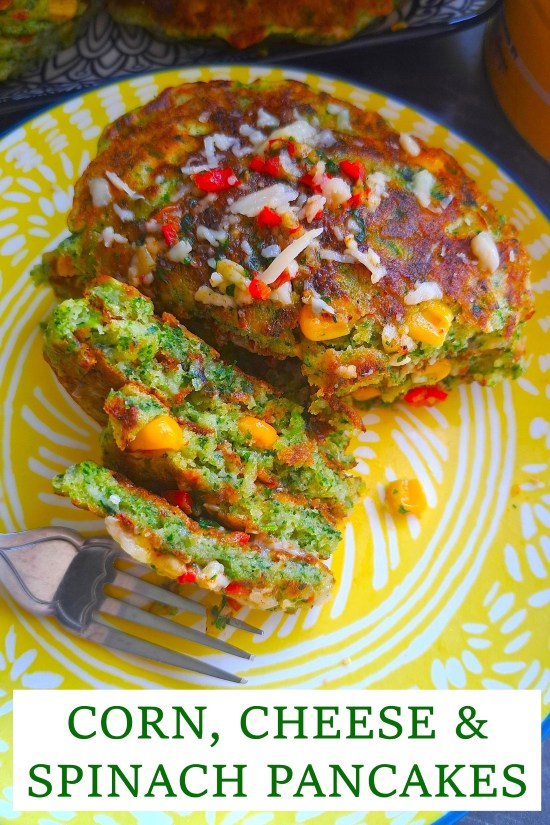
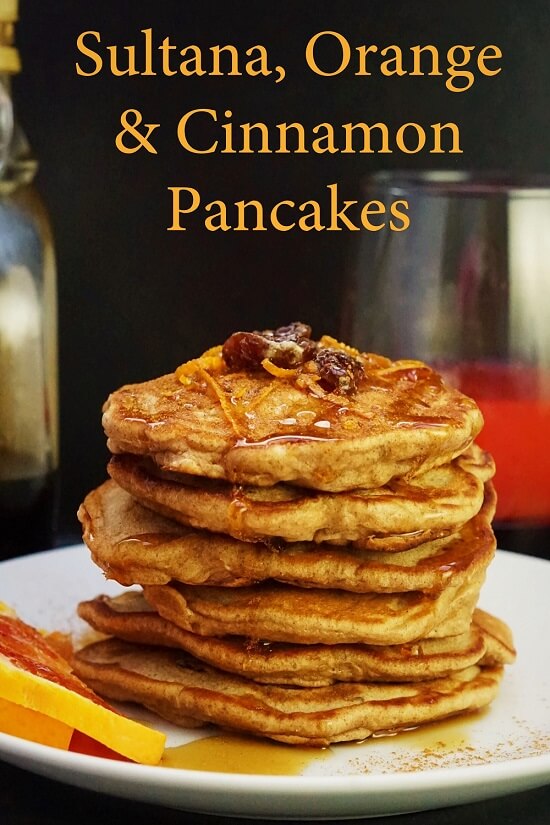
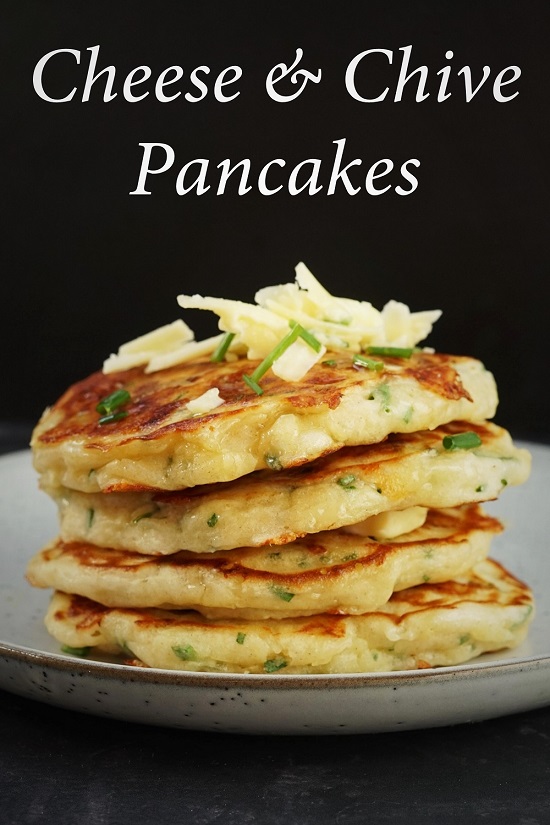
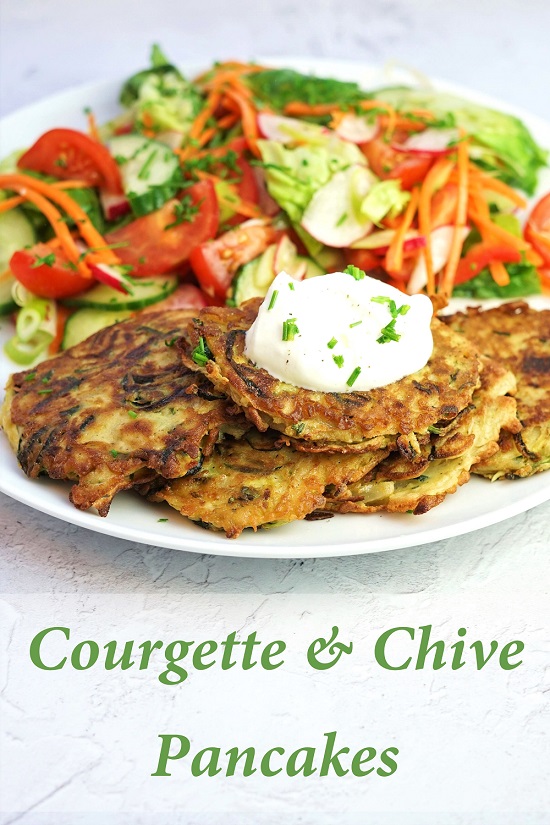
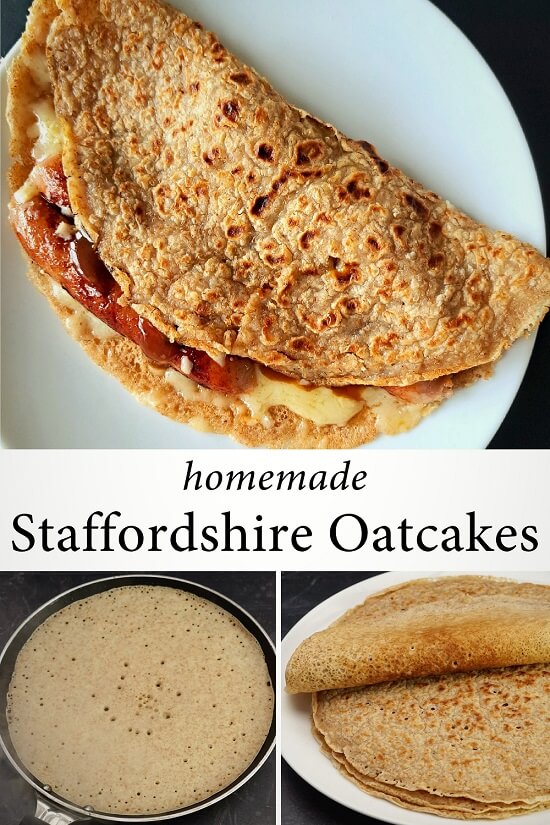
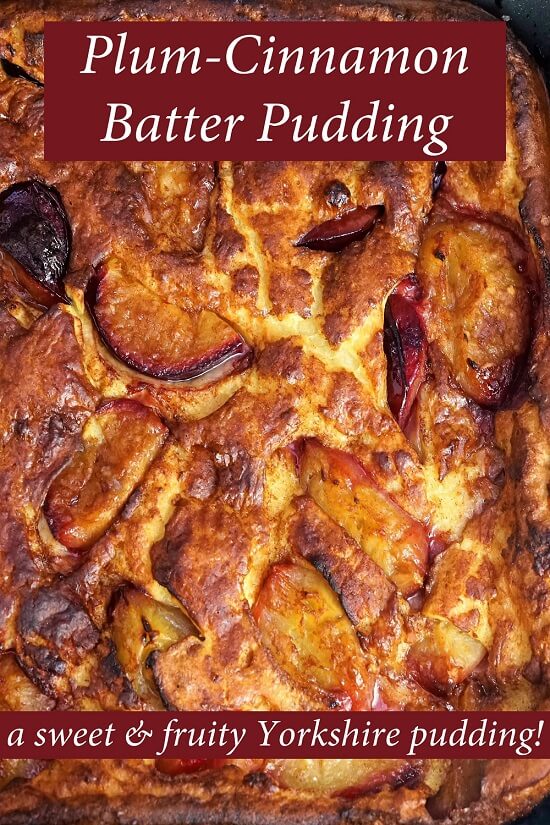
I’ve tried so many crepe recipes over the years and thought I was resigned to using the shaker bottle mixes forever…but then I found yours!!
This is such a great recipe for pancakes. And all of the technique tips!! I fancy myself a reasonable cook & baker but reading about whisking the milk & eggs in the well and slowly incorporating the flour from the sides was a real lightbulb moment for me.
Thank you so much for taking the time to share it!
Thank you Natasha, you’re welcome!
A simple, delicious recipe. I halved the ingredients and there were plenty of pancakes for two. I lappreciate that this recipe does not require sugar. Thanks for sharing it!
You’re welcome! Thanks so much for taking the time to give your great feedback 😀.
Followed the recipe exactly and they were awesome… quick and easy and so good!
Thank you, Jacqui!